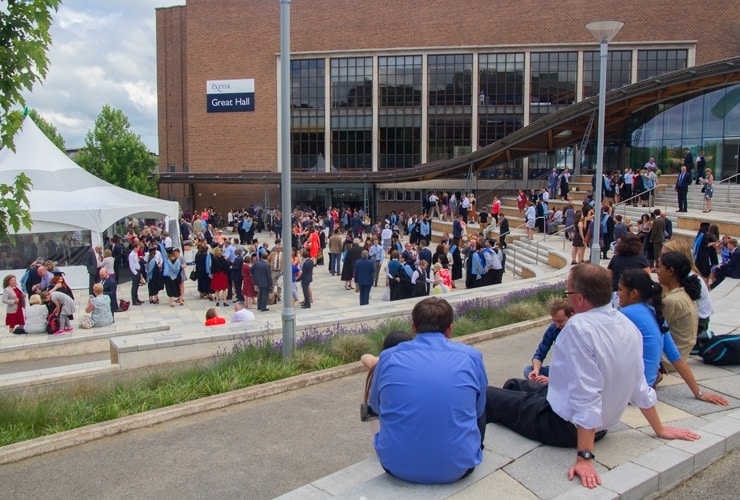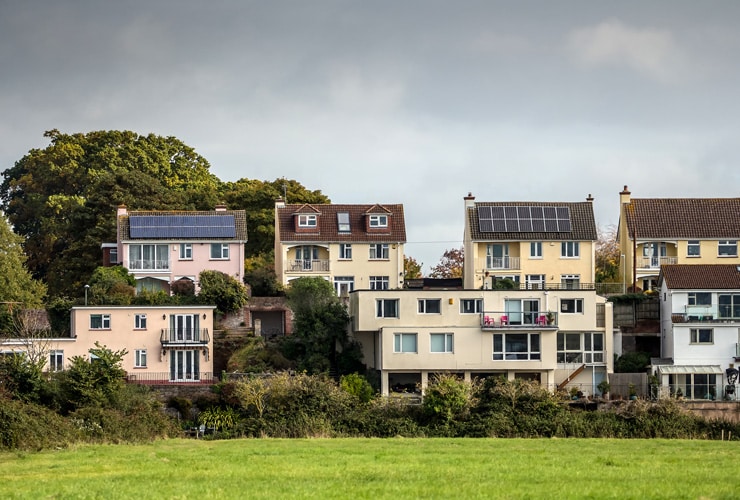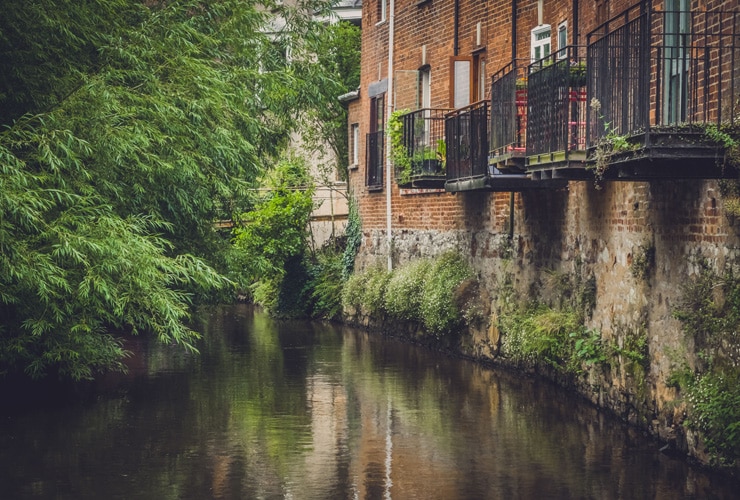Areas of Exeter: Property Investment Buy-to-Let Hotpots
Once upon a time, Exeter was the sort of place that didn’t have much to offer the property investor. It was a sleepy, behind-the-times backwater where nothing much happened.
But today it’s a different story! Exeter has transformed over the last couple of decades. It has attracted new industries and new jobs and developed a thriving economy. It’s gained a reputation as a vibrant, fashionable place to live and work. So today, Exeter is JUST the sort of place that you SHOULD consider for property investment.
Why Invest in Exeter?
Exeter is a vibrant and growing city with a lot to offer, making it an attractive prospect for property investors. With a current population of around 134,579 and a travel-to-work population of 470,000, Exeter is expected to grow further, with forecasts predicting an additional 25,000 people by 2030.
The city has an ambitious "Livable City Plan", aiming to build 12,000 new homes, improve infrastructure, and position Exeter as a global city by 2040. Exeter's economy is strong and diverse, with key sectors including services, public services, health, education, retail, distribution, and research and development. The city is also a significant tech hub, providing 10,000 jobs.
According to EY, Exeter is set to be one of the UK's fastest-growing cities over the next few years, outpacing cities like Birmingham. Exeter has seen major commercial development, including the Exeter Science Park, the Met Office headquarters, and the Exeter and East Devon Enterprise Zone.
The University of Exeter has a significant student population of around 22,000, which is good news for investors in student accommodation. Popular areas for students include the city centre, Pennsylvania, Stoke Hill, St. Davids, St. Thomas, and St. Leonards.
Exeter's strategic location is another advantage, offering easy access to the coast, Dartmoor, and the Devon countryside, as well as excellent transport links to London and other major cities.
With its thriving economy, diverse employment sectors, and ambitious development plans, Exeter is an attractive and promising location for property investors.

Amenities, Attractions and Transport
Exeter is a vibrant city with a unique mix of amenities, offering residents and visitors a wide range of options. Located on the River Exe in southwest England, it is just a 20-minute drive from the coast and a similar distance to the stunning Dartmoor National Park and the rolling Devon countryside. Even London is only two hours away by train.
Exeter also has a small airport, Exeter International Airport, which is about six miles from the city centre. The airport has been undergoing various improvements, including a new road scheme that will create around 1,000 new jobs and enhance the airport's connectivity. The airport offers both scheduled and holiday charter flights within Europe.
Exeter benefits from a range of high-end shops, including John Lewis, Waitrose, and IKEA. The presence of these retailers is often seen as an indicator of an area's wealth, which is good news for investors.
The city also boasts a variety of cultural and leisure amenities. Exeter's Historic Quayside is a popular area, offering antique shops, art exhibitions, local bars, and waterside restaurants. For sports enthusiasts, there is Sandy Park for rugby, St James' Park for football, and Exeter Racecourse for horse racing. Exeter is also home to the South West's largest indoor climbing wall and Europe's first Clip 'n Climb centre.
For those seeking a break from city life, Haldon Forest offers a peaceful escape just outside Exeter, with woodland trails, beautiful views, and outdoor activities like Go Ape!
With its convenient location, excellent transport links, and diverse range of amenities, Exeter truly offers something for everyone.

Property Values
As of April 2024, Exeter has relatively high property prices. According to Zoopla, the average sold price for a property in Exeter over the last 12 months was £348,585. However, property prices vary within the Exeter postcode area, with the most affordable place being 'EX4 3', where the average price is £205,000, and the most expensive being 'EX13 8', where the average price is £668,000.
The average property price in the Exeter area is £356,000, with a median price of £302,000. The average price of an established property is £356,000, while a newly built property will cost you £377,000. Property prices in Exeter have declined by £7,400 (2%) over the last year, and sales have dropped by 36.9%.
Despite these recent trends, Exeter still offers affordable investment opportunities. Online listings show that property prices in Exeter start from around £90,000, and it is still possible to buy a house for under £100,000.
With Londoners moving to Exeter in droves, the Exeter property market is booming, and property prices are expected to rise.
Average Asking Price by Postcode Area
Last updated: July 2024
Data from HM Land Registry
| Postcode District | Average Property Price |
|---|---|
| EX1 | £358,008/td> |
| EX2 | £354,134 |
| EX3 | £705,070 |
| EX4 | £309,962 |
| EX5 | £400,042 |
| EX6 | £433,198 |
| EX7 | £326,626 |
| EX8 | £367,353 |
| EX9 | £504,047 |
| EX10 | £458,475 |
| EX11 | £512,248 |
| EX12 | £381,538 |
| EX13 | £388,251 |
| EX14 | £336,838 |
| EX15 | £377,861 |
| EX16 | £355,650 |
| EX17 | £386,678 |
| EX18 | £426,050 |
| EX19 | £379,635 |
| EX20 | £363,232 |
| EX21 | £445,9489 |
| EX22 | £396,995 |
| EX23 | £401,868 |
| EX24 | £536,804 |
| EX31 | £379,461 |
| EX32 | £307,201 |
| EX33 | £483,687 |
| EX34 | £327,468 |
| EX35 | £365,258 |
| EX36 | £362,093 |
| EX37 | £377,177 |
| EX38 | £278,220 |
| EX39 | £317,588 |
Landlord Licensing
Exeter City Council requires all HMO landlords to have an HMO license and has Article 4 Directions in place in some areas, which restrict the conversion of standard homes into HMOs. The council does not, in early 2024, run a Selective Licensing scheme although it is worth noting, that the Council are within their rights, as set out in the Housing Act 2004, to bring in a Selective Licensing Scheme at any time, as many local authorities have done over the last few years.
Selective Licensing schemes are not without controversy and require all private landlords to have a license (meaning they commit to certain housing standards). There is currently no such scheme in Exeter but this could change, so it is always worth keeping an eye on the council's website for updates.
HMO Licensing
Exeter City Council operates a mandatory HMO licensing scheme as is standard across England and Wales. This scheme applies to HMOs with five or more occupants who aren't family, sharing facilities such as a kitchen or bathroom. The licensing fees for 2024/2025 are split into two parts. As of April 2024, Part A costs £290, and Part B costs £750 plus a bedroom charge of £10.50 per bedroom for bedrooms six and above.
Article 4 Directions
Exeter City Council established an Article 4 Direction in January 2014 to restrict the permitted development rights of homeowners to change their properties from dwellings to Houses in Multiple Occupation (HMOs). The Article 4 area in Exeter is generally between the Streatham campus and the city centre, covering popular locations for student accommodation.
Local Landlord Associations
The Devon Landlords' Association is a not-for-profit association for landlords by landlords, providing help, advice, and support to its members. Membership currently exceeds 500 and is growing.
The South West Landlords Association (SWLA) offers a Landlord Accreditation scheme, recognised and supported by several local authorities, including Exeter City Council. The scheme aims to encourage good standards and management practices among landlords and assist them in understanding their responsibilities.
To gain accreditation status, landlords must complete the LASW one-day training course, be deemed a "fit and proper person" by their local authority, and agree to abide by the LASW terms and conditions and code of conduct.

Rental Demand
Exeter's rental market is currently very competitive, with high demand from prospective tenants. There are a range of factors at play. The return to in-person work is one and the last few years seeing a post-lockdown housing boom is another. But by far in a way, the biggest pressure on Exeter's rental market is an ever-increasing number of people relocating there, to escape the high rents of London.
According to Zoopla, rents are rising by an average of 7.8% a year, down from 11% in early 2023. By the end of 2024, rent rises are expected to stabilise at around 5% per annum.
The Exeter rental market offers a variety of property types, with 2-bedroom properties being the most common, accounting for 35.3% of the market. The average rent in Exeter varies depending on property type, with prices starting at £547 for a single room and rising to £2,257 for a house with four or more bedrooms.
With a range of desirable properties and high tenant demand, Exeter's rental market is expected to remain strong in the coming year.
Average Rental Yield by Postcode Area
Rental yield is the rental return an investor can expect on their investment once costs have been taken into consideration. Please note we do not have rental yield data for all EX postcodes and have only included those postcodes that we have data for.
Last updated: July 2024
| Postcode District | Average Rental Yield |
|---|---|
| EX1 | 4.8% |
| EX2 | 4.7% |
| EX3 | 2.9% |
| EX4 | 5.6% |
| EX5 | 3.8% |
| EX6 | 3.3% |
| EX7 | 4.0% |
| EX8 | 4.1% |
| EX9 | 3.2% |
| EX10 | 2.8% |
| EX14 | 3.6% |
| EX15 | 3.4% |
| EX16 | 3.0% |
| EX17 | 3.1% |
| EX20 | 2.8% |
The Best Places to Live in Exeter
When it comes to deciding where to live in Exeter, there are several desirable areas to consider, although, of course, it depends on personal preferences and circumstances. However, subjective as it may be, here are some of the best places to live in Exeter:
- St Leonards: This area is very popular due to its proximity to hospitals and schools, as well as its convenient location within walking distance of the city centre. St Leonards is known for its village feel and sought-after schools. It is also the most expensive area in the city.
- Pennsylvania: Another popular area, Pennsylvania is well-located and offers a range of housing options.
- Heavitree: Heavitree is a sought-after area, known for its convenient location and vibrant community.
- Alphington: Alphington is a family-friendly neighbourhood with good schools and plenty of parkland nearby. It is a bit outside the city centre, making it ideal for those who want a quieter location.
- Topsham: This small but busy estuary town is popular with locals and tourists alike. Topsham has a great village feel, and its high street is full of character, with local independent shops, pubs, and restaurants. The Strand is one of the most sought-after streets in Topsham, where houses sell for premium prices.
- Countess Wear: This area is recommended for those who want to be close to the river and have easy access to the city centre.
- Isca Place and Richmond Court: These modern developments are ideal for young, childless individuals or couples who want to be in the heart of the city, with shopping centres, pubs, and transport links nearby.
- Exeter Quayside: Exeter Quayside offers loft-style apartments with river views and is just a 10-minute walk from the city centre, making it a convenient and desirable location.
- The Cathedral Quarter: Located in the heart of the city, the Cathedral Quarter boasts an 800-year-old cathedral and a range of independent shops and restaurants.

Property Investment in Exeter
Exeter is a compact city comprising lots of small suburbs and districts. Here’s a quick guide to the property market in many of them.
City Centre
Population: 7,000
Average House Price: £307,187
Exeter doesn’t have a huge city living market, but more people are recognising the benefits of living right in the centre. There are converted and newly built apartments and also smart townhouses. It’s also popular for student living.
Alphington
Population: 8,250
Average House Price: £360,689
To the south-west of the city centre, Alphington has good links to the A38, A30 and M5. It is also very close to the Marsh Barton commercial/industrial area where 6,000 people work. There are also plans to open a new railway station here too – something that usually boosts property prices.
Beacon Heath
Population: 8,800
Average House Price: £296,667
Beacon Heath on the northern fringes is mostly made up of social and private housing estates and is a lower-priced area of Exeter good for budget buy-to-lets.
Property investors could expect a yield of 6.6% here (based on EX4 postcode).
Countess Wear
Population: 9,200 (including Topsham)
Average House Price: £367,979
Countess Wear has great access to the M5 and the business parks in the east of the city. It is a mid-priced property area.
The area (based on EX2) offers a 4.8% yield.
Cranbrook
Population: 7,500
Average House Price: £294,741
Cranbrook is a new town – which eventually will have 8,000 new homes – out to the east of Exeter itself near the airport. Cranbrook offers good value new builds. It has its own schools and local amenities and even a station with trains into Exeter and to London.
Yields here (EX5) are around 3.9%.
Exwick
Population: 9,400
Average House Price: £286,445
Exwick is across the River Exe to the west of the city centre. It is one of Exeter’s cheaper property areas, so popular with those on a budget. It also benefits from being within walking distance of Exeter St. David’s station.
EX4 yields are typically 6.6%.
Heavitree
Population: 13,200
Average House Price: £326,560
Just to the east of the centre, with great city-centre access, Heavitree is one of the city’s most popular residential districts. It is a mid-upper priced area and particularly popular with families.
Investors in this area (based on EX1) can expect a yield of 5.6% and up.
Pennsylvania
Population: 12,500
Average House Price: £433,159
Pennsylvania occupies an elevated spot on the northern fringes of the city centre. It’s one of Exeter’s most popular residential areas and also, in part, popular for student accommodation.
Yields in the area are generally 4%, but a good student property should return more.
St. Leonards
Population: 5,800
Average House Price: £421,573
Close to the city centre and Exeter’s impressive cathedral St. Leonards is one of Exeter’s most upmarket areas and very popular with professionals and families. As a result, it’s one of the city’s most expensive areas.
St. Thomas
Population: 8,250
Average House Price: £274,112
Also across the River Exe from the city centre, St. Thomas is a good value area in Exeter property terms. Buy-to-let landlords could expect a 4% yield here.
Stoke Hill
Population: 8,600
Average House Price: £270,993
On the northern fringes of the city, Stoke Hill is a popular mid-priced residential area and one that appeals to families.
Topsham
Population: 9,200 (including Countess Wear)
Average House Price: £506,156
South of the city itself and on the River Exe Topsham is one of Exeter’s most popular residential areas, but also one of the more expensive. This means yields are tight though, around 3%.
Wonford and St. Loyes
Population: 13,700
Average House Price: £393,142
Wonford is to the east of the city centre and is close to the Royal Devon & Exeter Hospital. It is generally a lower-price area offering good value ex-social properties which appeal to budget investors.
Other Areas To Consider
Rising property prices in Exeter itself have encouraged buyers to look at surrounding towns in search of property bargains. Here are some other areas to consider.
Crediton
Population: 6,800
Average House Price: £273,193
The small town of Crediton is just 8 miles northwest of Exeter. It appeals to families and commuters who want to live in a more rural location. There’s a direct train taking about 15 minutes.
Yields in EX17 are 3% on average.
Exmouth
Population: 34,400
Average House Price: £377,271
Exmouth is a resort town popular with retirees and also families who want to live by the sea. Trains into Exeter take around 30 minutes.
Yield in EX8 is upwards of 3%.
Honiton
Population: 11,800
Average House Price: £287,080
Honiton is 17 miles west of Exeter. It’s another commuter favourite being linked by the A30 dual carriageway and a direct train service.
EX14 offers investors an average of 3.5% return.
Torquay
Population: 65,200
Average House Price: £291,638
The resort town of Torquay is generally far cheaper than Exeter. It has become popular with some Exeter commuters in recent years. However, it’s also popular with investors for good value buy-to-lets and house shares.
Yields in TQ1 are around 4.2%.
